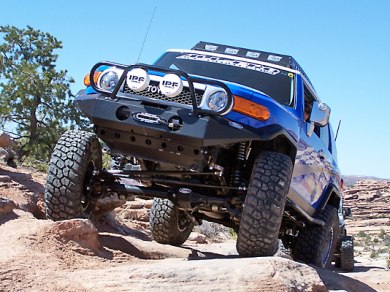
Before you venture into the great unknown with your 4×4 truck, you need to become familiar with your vehicle, learn its limitations and take certain precautions.
You have to do a visual inspection and figure the answers to various questions. For example, what is your vehicle’s ground clearance? How big of a rock can you drive over without worrying about hitting something unprotected under your truck?
The firs thing to do is strap everything down inside. If you suffer a rollover, you don’t want to get hit by a beer can on the head. Make sure the battery is also restrained? If the battery jumps out of its housing, it can touch metal parts and short out, leaving you stranded.
Figure out your approach angle. If your bumper hits the slope before your front wheels do, you’ll have to come at the slope from an angle. Similarly, figure out your departure angle? If you exceed your departure angle then your rear bumper will hang up on the hill and your rear wheels will leave the ground.
You should be aware of the types of differentials on your truck, and their position underneath the chassis. This is important to consider when going over tall obstacles.
Remember that certain engines cannot handle being driven at an angle. If it is carbuerated, a steep grade can drown it quickly. Fuel-injected vehicles generally handle steep grades better. Diesels and cylinder-injected gasoline vehicles can run at the weirdest angles without any issues whatsoever.
Be careful if your vehicle has a high center of gravity, making it more susceptible to tipping and rolling. Most 4×4 vehicles suffer from tipsiness to various degrees.
If using larger aftermarket tires, make sure you can manage full wheel travel without hitting the fenders. With balloon tires, it is quite possible that the tire hits the fender before the axle hits the bump-stop. Jack up one front wheel high enough for the axle to hit the bump-stop and run your hand around the tire to see if it’s hitting anything. Now turn the wheel full to the left and check. Now turn it to the right. If it hits anything then you have to decide whether you want to tear up your tires and bodywork by doing seriously-angled off-roading. Check the rear wheels too.
While they are good items in open desert areas, long 6-feet long whip antennas aren’t allowed on some popular trails due to the damage to trees that they can inflict. It could also be a safety issue for bystanders in cramped locations.
Check if any of your fluids are low. Check the levels of power steering fluid, engine oil, coolant, windshield washer fluid, and brake fluid. Have your brakes checked to see if you need to replace the pads or shoes. If you’re traveling in a group at night, check your headlights and taillights.
© ModernOffroader.com






























